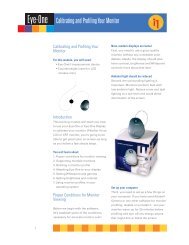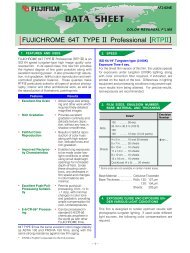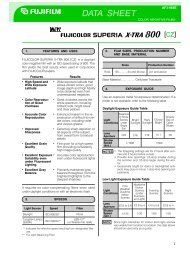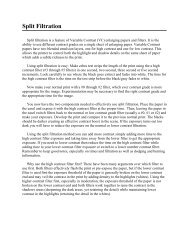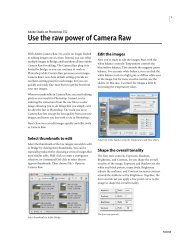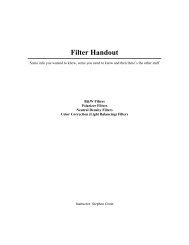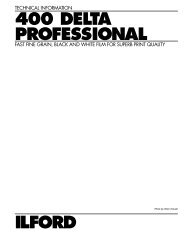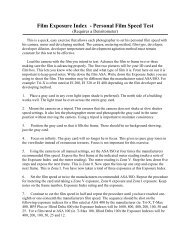Polaroid Type 53 (Polapan Pro 800) - Stephen Grote
Polaroid Type 53 (Polapan Pro 800) - Stephen Grote
Polaroid Type 53 (Polapan Pro 800) - Stephen Grote
Create successful ePaper yourself
Turn your PDF publications into a flip-book with our unique Google optimized e-Paper software.
Film Data Sheet<br />
T-<strong>53</strong><br />
4 x 5 Black & White Sheet Film<br />
Film Speed<br />
ISO <strong>800</strong>/DIN 30<br />
Format<br />
4 x 5 in. (10.2 x 12.7 cm)<br />
Sheet Film<br />
Image Area<br />
3 1 /2 x 4 1 /2 in. (9 x 11.4 cm)<br />
Finish<br />
Glossy<br />
<br />
<br />
<br />
<br />
<br />
<br />
Exposures per Unit<br />
20 exposures per box<br />
Description<br />
Medium-contrast 4 x 5 sheet film for detailed black & white<br />
prints. Coaterless, wide tonal range for excellent highlight and<br />
shadow detail.<br />
Key Applications<br />
• SEM imaging<br />
• Microscope imaging<br />
• Test shots<br />
• Copystand photography<br />
Compatible Hardware<br />
• Any instrument or camera equipped with a Model 545/545i<br />
Film Holder<br />
• MP-4+ Camera<br />
Special Treatment<br />
<strong>Pro</strong>cessing the film for longer than 3 minutes may affect<br />
image contrast and density to some extent. For optimum<br />
image stability at temperatures above 75°F (24°C), film should<br />
not be processed for longer than one (1) minute. At colder<br />
temperatures, process the film for a longer time as indicated<br />
in the chart below. A picture processed for too short a time<br />
will have dull grays, mottle and little contrast. However, if<br />
more contrast is required, the processing time may be extended<br />
by 15 seconds (for example, process for 60 seconds<br />
rather than 45 seconds). This may increase the contrast and<br />
density, but may also result in some loss of gray.<br />
Development Time<br />
45 seconds at 70°F<br />
Caution<br />
This film uses a small amount of caustic paste. If any paste appears, avoid contact with skin, eyes and<br />
mouth and keep away from children and animals. If you get some paste on your skin, wipe it off<br />
immediately, then wash with water to avoid an alkali burn. If eye contact occurs, quickly wash the<br />
area with plenty of water and see a doctor. Keep discarded materials away from children, animals, clothing<br />
and furniture.<br />
Limited Warranty<br />
See information on the film box<br />
.<br />
“<strong>Polaroid</strong>” is a registered trademark of <strong>Polaroid</strong> Corporation, Waltham, MA 02451 USA.
Film Data Sheet<br />
Technical Data<br />
T-<strong>53</strong> (4x5 sheet), T-5<strong>53</strong> (4x5 pack) and<br />
T-803 (8x10 sheet) - B&W High Speed Instant<br />
Peel-Apart Coaterless Film<br />
The information in this data sheet<br />
represents the typical performance<br />
of <strong>Polaroid</strong>’s T-<strong>53</strong>, T-5<strong>53</strong> and T-803<br />
black and white high speed films.<br />
Specific film lots may vary.<br />
3<br />
Characteristic H&D curve for normal,<br />
hot and cold development<br />
Recommended<br />
speed (ISO)<br />
Recommended<br />
processing time<br />
at 70 o F/21 o C<br />
Spectral<br />
sensitivity<br />
<strong>800</strong>/30 o<br />
45 seconds<br />
Panchromatic<br />
2<br />
55 0 F/13 0 C<br />
70 0 F/21 0 C<br />
95 0 F/35 0 C<br />
Resolution<br />
(1000:1)<br />
Contrast<br />
12 - 15 line<br />
pairs/mm<br />
Medium<br />
Sample Density<br />
<strong>Pro</strong>cessing time and temperature<br />
For best results process at temperatures<br />
above 60 o F(16 o C).<br />
1<br />
o F<br />
o C<br />
Time in<br />
seconds<br />
Exposure<br />
Adjustment<br />
95 35 30 -1/3 stop<br />
90 32 30 None<br />
75 24 30 None<br />
70 21 45 None<br />
65 18 60 None<br />
0<br />
-3<br />
-2 -1<br />
Relative Log Exposure<br />
0<br />
55 13 85 1/3 stop<br />
At 71 o F/21 o C: D-Max = 1.75 D-Min = .11 Slope = 1.64<br />
Filter factors<br />
Filter no. 6 8 15 25 47 58<br />
Light source at<br />
3200 o K - Tungsten<br />
Light source at<br />
5500 o K - Daylight<br />
Aperture<br />
adjustment<br />
(f-stops)<br />
Filter factor<br />
(exposure<br />
multiplier)<br />
Aperture<br />
adjustment<br />
(f-stops)<br />
Filter factor<br />
(exposure<br />
multiplier)<br />
1/3 1/2 2/3 1 1/2 3 1/2 3 1/2<br />
1.3 1.4 1.6 2.8 11.2 11.2<br />
2/3 1 1 1/3 2 1/2 2 2/3 3 1/3<br />
1.6 2 2.5 5.6 6.3 10<br />
D-Max: The density value for the film’s darkest black.<br />
D-Min: The lowest density value that a film exhibits. In<br />
prints, the whiteness of the brightest highlight, relative<br />
to the unprocessed print.<br />
Slope: The positive ratio of the log E increments of<br />
the straight line region of the curve, as determined by<br />
the 1/4-3/4 increment method. The slope of an H&D<br />
curve indicates the overall contrast of a film: low<br />
contrast slopes less than 1.10; medium contrast<br />
slopes from 1.10 to 1.70; high contrast slopes greater<br />
than 1.70.
Film Data Sheet<br />
Technical Data<br />
T-<strong>53</strong> (4x5 sheet), T-5<strong>53</strong> (4x5 pack) and<br />
T-803 (8x10 sheet) - B&W High Speed Instant<br />
Peel-Apart Coaterless Film<br />
Reciprocity law failure<br />
A wide range of shutter speeds can be used<br />
without loss of film speed. For longer exposure<br />
times, some exposure compensation is<br />
suggested.<br />
Indicated<br />
exposure<br />
time (sec.)<br />
Adjust aperture or time<br />
Aperture Corrected<br />
exposure<br />
time<br />
1000<br />
Spectral Sensitivity<br />
1/1000-1/10 None Same<br />
1 +1/3 stop 1 1/2 sec.<br />
3 +2/3 stop 7 sec.<br />
10 +1 stop 25 sec.<br />
30 +1 1/3 stop 85 sec.<br />
Spectral Sensitivity<br />
100<br />
10<br />
100 +1 2/3 stop 450 sec.<br />
1<br />
350<br />
400 450 500 550 600 650 700<br />
Modulation Transfer Function<br />
Wavelength (nm)<br />
100<br />
80<br />
Reciprocity Law Failure<br />
% Modulation<br />
60<br />
40<br />
20<br />
0<br />
1 2 3 4<br />
Spatial Frequency (cycles/mm)<br />
Speed Change (f -stops)<br />
0.5<br />
0.0<br />
-0.5<br />
-1.0<br />
-1.5<br />
-2.0<br />
-2.5<br />
-3.0<br />
-3.5<br />
.001 .01 .1 1 10 100<br />
Exposure Time (seconds)<br />
Speed variation relative to color temperature<br />
3200 o K 4<strong>800</strong> o K 5500 o K 6500 o K 7500 o K 10,000 o K<br />
-1/3 stop - - - +1/3 stop +1/3 stop<br />
Reciprocity: The ability of the film to respond in a constant manner to a<br />
constant exposure (light intensity x time). Reciprocity failure occurs<br />
during very long or very short exposures, requiring the photographer to<br />
increase exposure.



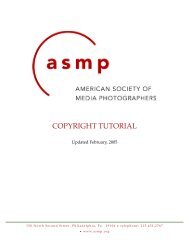
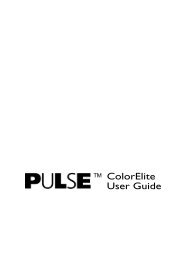

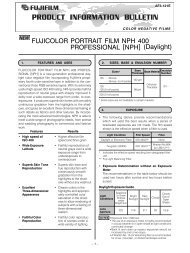
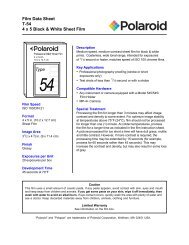
![FUJICOLOR NPH 400 PROFESSIONAL [NPH] - Fujifilm USA](https://img.yumpu.com/27607653/1/190x253/fujicolor-nph-400-professional-nph-fujifilm-usa.jpg?quality=85)
